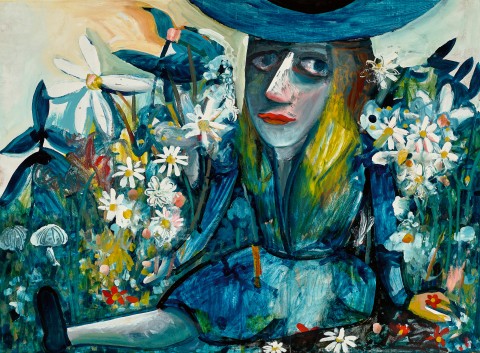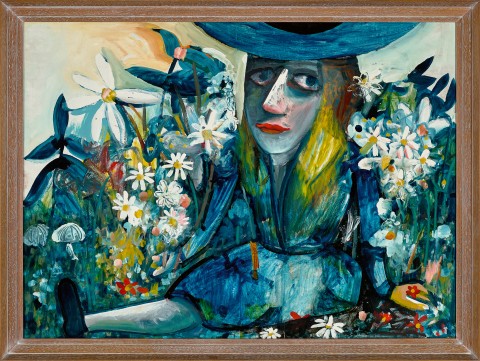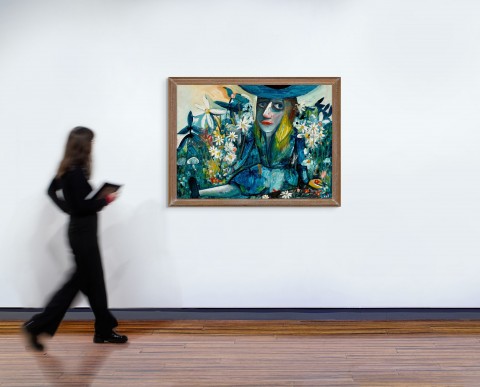(1928 - 2018)
Charles Blackman
Alice amongst flowers, c.1956 - 57
oil and enamel on composition board
Clune Galleries, Sydney (label attached verso)
Kurt and Margaret Enoch Woodstock, New York, USA
Estate of Margaret M. Enoch, New York, USA
Christie’s, London, 12 December 2007, lot 42
Private collection, Melbourne
‘Charles Blackman’s legacy more than Alice’, The Canberra Times, Canberra, 20 August 2018 (illus.) https://www.canberratimes.com.au/story/5595350/charles-blackmans-legacy-... (accessed July 2025)
‘Down, down, down. Would the fall never come to an end? ‘I wonder how many miles I’ve fallen by this time?’ she said aloud. ‘I must be getting somewhere near the centre of the earth. Let me see: that would be four thousand miles down, I think’… ‘I wonder if I shall fall right through the earth! How funny it’ll seem to come out among people that walk with their heads downwards! The Antipathies, I think’ – she was rather glad there was no one listening, this time, as it didn’t sound at all the right word – ‘but I shall have to ask them what the name of the country is, you know. Please, Ma’am, is this New Zealand or Australia?’1
In 1956, when Charles Blackman first encountered Lewis Carroll’s beloved children’s book, Alice’s Adventures in Wonderland (1865), he was not a child but rather, a mature, married man who was soon to become a father. Blackman’s introduction to Carroll’s absurdist tale of fantasy and adventure – which begins with Alice following the White Rabbit down the rabbit-hole – was through a talking book which his wife, Barbara, who was legally blind, had borrowed from the library. Blackman had grown up in a house devoid of books and while he had heard of the famous story, he had never read it or seen any of the associated illustrations.2
Blackman listened to the story repeatedly and later recalled:
‘I was absolutely thrilled to bits with it… and it seemed to sum up for me at that particular moment my feelings towards surrealism, and that anything could happen. The cup could lift off the table by itself, the teapot would… pour its own tea… The world is a magical and very possible place for all one’s dreams and feelings. One is completely outside of reality… This was sparked completely off by Barbara’s influence on my life.’3
Blackman attended evening classes at the East Sydney Technical School during the early 1940s and later, undertook a handful of painting classes with Hayward Veal at the Meldrum School of Painting which constituted his only formal art training. From 1946 – 47 he participated in life drawing classes at the Society of Realist Art and it was at this time that Blackman met Lois Hunter, an avant-garde poet from New Zealand who introduced him to modern art and literature.4 Blackman followed Hunter to Brisbane in 1948 where he befriended local artists and writers, including Barbara (née Patterson) and Barrett Reid, both members of the local Barjai group of poets. Blackman and Barbara later moved to Melbourne and were married in 1951. Blackman conceded that ‘it wasn’t until Barbara and I were actually living together that I really started painting pictures’5 and during the following twenty years of marriage their relationship provided a solid and nurturing foundation for family, friendship and sustained creativity.
Barbara’s pension for the sight-impaired and work as a life model allowed Blackman the freedom to paint full time, but this was curtailed by her first pregnancy in 1956, prompting him to find employment as a cook at the Eastbourne Café (better known in its later incarnation as Balzac restaurant) in Wellington Parade, East Melbourne. The café was run by his friend, Georges Mora, a European émigré who, with his beautiful young wife, Mirka, soon became what Barbara described as the ‘vortex of our marvellous lives’, their apartment in Grosvenor Chambers at the ‘Paris End’ of Collins Street being a ‘centre of gravity (and much levity), the place of exhibitions, meetings, parties, dramatic moments, tableaux vivants, plots, confrontations, improvisations, last suppers, diagnoses and prognostications, exhibition after exhibition’.6 The café was busy and according to Blackman his efforts, ‘used to be referred to as the kitchen ballet. I used to leap from fridge to plate… my record was serving a hundred and four meals, three courses… in under two hours’.7 It was while he was working here that Blackman began to draw the images that formed the basis of the Alice in Wonderland series. As he recalled, ‘I … finished at 12[am] and then came home and my head was full of spinning plates and teacups … The restaurant came into the paintings.’8
There were other influences at work too. In late June 1956 Sidney Nolan exhibited his now iconic Ned Kelly and Blackman attended the opening at the new Gallery of Contemporary Art in Tavistock Place, Melbourne. Barrett Reid had introduced Nolan to Blackman in Brisbane in 1947 and they connected again in Melbourne through John and Sunday Reed whose home, Heide, was a cultural refuge for many of the most avant-garde artists, writers and thinkers of the day. Blackman had been impressed by Nolan’s art, identifying with his ability to ‘[trap] inner feeling in the paint’. While Blackman had already begun the Alice paintings, seeing Nolan’s Kelly exhibition inspired him to develop them into a major series. The image of Ned Kelly and his stylised black mask became a touchstone within Nolan’s oeuvre and he returned to the subject repeatedly throughout his career. In a similar way, the White Rabbit – mischievous, masculine and playful, an anthropomorphised representation of the artist himself – became a recurring motif in Blackman’s later work.9
Blackman also responded to the way in which Nolan incorporated references to his own life into the Kelly paintings and related the miraculous transformation of Barbara’s pregnancy to Alice’s fantastic experiences, as well as her increasing blindness and the spatial disorientation this caused. In addition to these very personal connections, as Felicity St John Moore has documented, the series also incorporates symbolic references to Nolan and the Reeds, the Boyd family home at Murrumbeena, as well as pictorial allusions to contemporary artworld politics.10 Add to this the couple’s interest in Surrealism and appreciation of the absurd and irrational, combined with various everyday items that Blackman appropriated for his compositions, and all of the ingredients for what would become one of the most renowned series of paintings in modern Australian art were in place.
The series was launched in early 1957 at the exhibition, Paintings from Alice in Wonderland, which was held at the Gallery of Contemporary Art. The exhibition was far from a commercial success and while it did attract considerable comment in the newspapers, Arnold Shore was the most enthusiastic, writing that ‘Salient incidents… are freely interpreted and the artist’s purpose is to suggest the magical topsy-turvy world which the heroine met in her journey through wonderland. Thus, teapots pour of their own volition and bottles of ink fly through the air as the artist seeks to convey the humour of the Mad Hatter’s tea party.’11
The subject of Alice and her adventures in Wonderland continued to engage Blackman through to 1957 with exhibitions that year in Melbourne and Brisbane. Alice amongst flowers, c.1956 – 57, was sold privately by Clune Galleries, Sydney to American publisher, Kurt Enoch and his wife, Margaret, on their visit to Sydney in March 1959. Clune Galleries, which opened in 1957, presented the exhibition Recent Paintings by Charles Blackman, in July 1958, one of its first by a solo artist. The artist’s delight in the varied form and colour of this botanical subject-matter is palpable and he lays down the paint – with an emphasis on the familiar palette of blue, yellow and white that is a feature of many of the Alice pictures – with a sense of freedom and energy that demonstrates both his confidence and great facility with the brush. There is a distinct tension that runs throughout the Alice series and its depictions of a young, carefree girl (Alice) who is on an extraordinary adventure, and the parallel symbolic representation of a mature woman (Barbara) confronting the trials and reality of her life. Skilfully exploiting this dynamic, here, Blackman reminds us that the girl amidst the flowers, a freshly-picked posy in her right hand, is not all innocence and fun. Bright red lips and brooding eyes direct us back to the adult world and the challenges of Barbara’s increasing blindness. If the intensity of her gaze suggests a knowing sense of resignation, the depiction of the figure in a space that is filled with flowers offers the promise of joy and delight amidst the seriousness and responsibilities of life.
With examples now represented in major private and public collections across the country, including the National Gallery of Victoria and Art Gallery of Western Australia, the Alice in Wonderland series represented a significant turning point in Blackman’s career. Alice was a subject that, in his words, ‘allowed me to paint in a totally different style. [To believe] that anything is allowable.’12 As his own life flourished, so did his art and his imaginative depiction of Barbara as Alice ‘[released] in Blackman… the imaginative capacity to explore freely, without the worry of strict realism or logic, that world of experience, of feeling, which exists in all of us.’13
1. Carroll, L., Alice’s Adventures in Wonderland: Illustrated by Charles Blackman, Amadio, N. (ed.), A. H. & A. W. Reed, Sydney, 1982, p. 14
2. St John Moore, F., ‘Conception to Birth: The Alice in Wonderland Series’ in St John Moore, F. & Smith, G., Charles Blackman: Alice in Wonderland, National Gallery of Victoria, Melbourne, 2006, p. 10
3. The artist interviewed by Robert Peach, Sunday Night Radio Two, ABC Radio, 9 September 1973 cited ibid.
4. For detailed biographical information see St John Moore, Charles Blackman: Schoolgirls and Angels, National Gallery of Victoria, Melbourne, 1993, pp. 15 – 29
5. Charles Blackman cited in Shapcott, T., Focus on Charles Blackman, University of Queensland Press, Brisbane, 1967, p. 13
6. Blackman, B., Glass After Glass: Autobiographical Reflections, Penguin, Melbourne, 1997, p. 172
7. St John Moore, 2006, op. cit., p. 11
8. Charles Blackman cited in Shapcott, T., The Art of Charles Blackman, Andre Deutsch, London, 1989, p. 23
9. ibid., p. 26. In addition to illustrating a 1982 publication of Lewis Carroll’s story with a selection of the Alice paintings and some new watercolours and drawings (see footnote 1), Blackman was commissioned to design the program and sets for Alice in Wonderland, a ballet performed in Perth in 1984.
10. See St John Moore, 2006, op. cit., p. 169
11. Shore, A., ‘Painter in Alice’s Wonderland’, The Age, Melbourne, 12 February 1957, p. 2
12. Amadio, N., Charles Blackman: The Lost Domains, A. H. & A. W. Reed, Sydney, 1980, p. 25
13. Shapcott, 1967, op. cit., p. 30
KIRSTY GRANT


